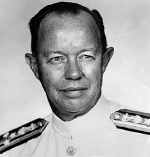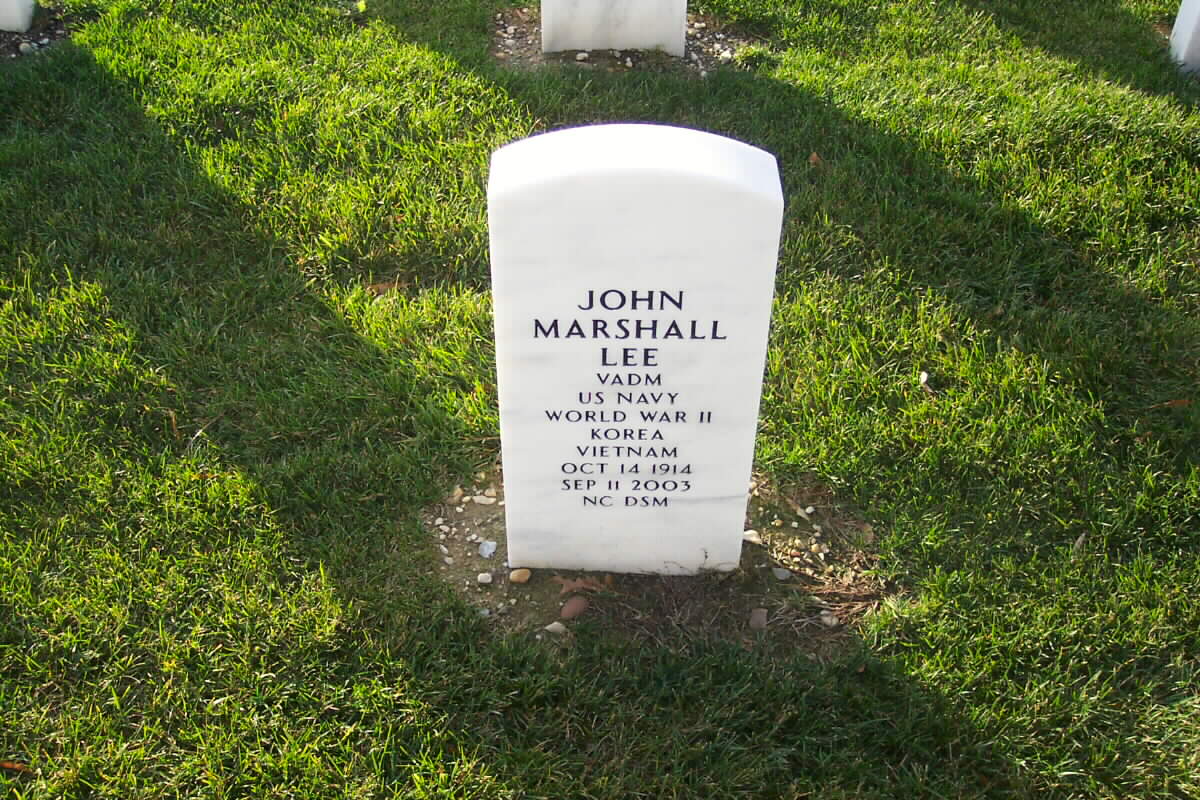Vice Admiral John Marshall “Squidge” Lee, U.S. Navy (retired), 88, died on September 11, 2003, in Ennis, Montana.
Born in the Presidio of San Francisco, California, on October 14, 1914, Admiral Lee was the son of the late Lieutenant Colonel Alva Lee, U.S. Army (U.S. Naval Academy Class of 1908) and Mrs. Cary Marshall Lee. He entered the Naval Academy as a midshipman at age 16 in June, 1931, and graduated third in his class in 1935. On graduation, he was commissioned Ensign and, after serving through the grades, was made Vice Admiral in 1967. After 42 years on active duty, he retired in April, 1973, then the senior Vice Admiral in the Navy.
In 1940, Hope Gilmour Blandy and then Lieutenant Lee were married just as U.S.-Japanese tensions were coming to a boil. Their early married life was consequently hectic, but exciting. Hope, nicknamed “Toni,” was the daughter of Admiral William H.P. Blandy and Roberta Amies Blandy, and thus had also spent her childhood in a Navy family. Then, and for the rest of their nearly sixty years of devoted marriage, he felt she balanced perfectly the roles of Navy wife, mother, and concerned citizen (her favorite causes being civil rights and the environment).
Eighteen of his forty-two years on active duty were spent at sea. In World War II, he served initially in the cruiser Boise, in the Far East and in the South Pacific during the Guadalcanal campaign. He won the Navy Cross as Boise’s communications officer during the night gun battle of Cape Esperance, near Guadalcanal, in an area that came to be called “Iron Bottom Bay” from the many ships, American and Japanese, that were sunk there. In that action, the Boise sustained a number of hits, including one eight-inch shell that detonated in the largest powder magazine, killing over 125 men and putting two turrets out of commission. Because Lee stayed at his post on the bridge, despite the fire around him, the Boise was not lost.
During the remainder of World War II, he served on destroyers (as executive officer and captain) in the continuing operations in the Solomons and then in the Central Pacific during the assaults on Saipan and Guam and the Marianas Turkey Shoot. He ended the war with six campaign stars on hisAsiatic-Pacific service ribbon. His last wartime assignment was as Flag Secretary to Admiral Chester Nimitz, Commander in Chief Pacific.
After World War II, Lee’s sea duty included the command of three ships: a destroyer (Benner), an amphibious attack transport (Chilton), and a cruiser (Northampton). He served on the staff of Commander Amphibious Force of the Atlantic Fleet after a year’s study at the Marine’s amphibious warfare school in Quantico. In Chilton, he participated in the landings in Lebanon in 1958. From 1963 to 1965, then a Rear Admiral, he was Commander Amphibious Forces Seventh Fleet, operating in the Western Pacific during the Vietnam War. This involved the operation of 75 ships, frequently reinforced by additional ships, aircraft and ground forces drawn from all U.S. services and from Philippine, Korean and Chinese allies, operating in a theater stretching from Japan/Korea to Singapore.
In his service ashore, Lee focused on planning and policy-making in the international
military-political-diplomatic areas. Over the years, Lee met and advised presidents from Franklin Roosevelt to Richard Nixon. He served in the Navy, Defense and State Departments, in the NATO organization, in the U.S. Delegation to the United Nations, and in the U.S. Arms Control and Disarmament Agency. In these assignments, he was involved in the Berlin Crisis and the Cuban Missile Crisis. In 1967-69, while Vice Director of the NATO International Military Staff, he was centrally involved in moving that staff from Washington to Brussels and establishing its new relations with the NATO Council and the Major NATO Commanders. Subsequently, in 1969-70, he was on the United Nations Military Staff Committee and military advisor to the U.S. Ambassador to the U.N. From 1970 until his retirement, he was Assistant Director of the U.S. Arms Control and Disarmament Agency in Washington, where he participated in drafting and negotiating the SALT I treaty.
At retirement, in addition to the Navy Cross, he wore three Distinguished Service Medals, the Legion of Merit, three Bronze Stars with the Combat “V,” and the Commendation Medal with the Combat “V.”
After his retirement, the Lees moved to St. Petersburg, Florida. From 1973 until 1999, he continued to work on the major subjects that had concerned him most during his active duty. His professional writings included “To Unite Our Strength,” a book he wrote with two civilian colleagues advocating an improved United Nations military organization; a paper for the Union of Concerned Scientists, later published in two books and Scientific American, on the desirability of a policy of No-First-Use of nuclear weapons; and a section on nuclear strategy for the book “Prospects of Peace-Making.”
Sponsored by a number of organizations, he traveled extensively in the U.S. and abroad. In all these efforts, he continued to advocate cutbacks in nuclear weapons, reduction in nuclear readiness, and stopping anti-ballistic missile programs, all within the basic policy of eliminating nuclear weapons throughout the world.
In 1985, he, with others, traveled with Kim Dae Jung, later president of the Republic of Korea, when Jung returned to Seoul, Korea, after his exile, to help prevent Jung from meeting the same tragic fate as Philippine Senator Benigno Aquino.
He was a Commissioner of the Greater London Area War Risk Study for the Greater London Council, was on the board of directors of the Council for a Livable World, the American Committee on U.S.-Soviet Relations and on the Advisory Committee of the Ploughshares Fund. He was a member of the Council on Foreign Relations, the Federation of American Scientists, the Committee for National Security, the League of Women Voters, and the American Civil Liberties Union.
The Lees had three children. The oldest, John Jr., was killed in an automobile accident at the end of his first year at Princeton. The second, Catherine Blandy, “Kitty,” now married to A. J. Donich Jr., lives in Ennis, Montana. The youngest, Susan Gilmour, lives in Bozeman, Montana.
In early 1999, the Lees moved from St. Petersburg to Ennis. Shortly after arriving, Toni was felled by a stroke and died on May 20, 1999. Though he missed her intensely, Squidge became rapidly involved in life in Ennis and said that his four years there were some of the happiest in his life.
Besides his daughters and son-in-law, he is survived by his grandsons, A. J. Donich, III, of Denver,and John Marshall Donich, of Los Angeles; his granddaughter and her husband, Albee and Andrew Willett of Bozeman, Montana, and their children, his beloved great-grandchildren, Brooke Willett and Hudson Marshall Willett. He is also survived by his brother-in-law, Raymond Volkman of Salt Lake City; and nephews and nieces, Henry and Gale Volkman of Salt Lake City, John Marshall and Stephanie Volkman of Portland, Kirk Volkman and Tony Cummings of Salt Lake City, Elisabeth and James Cook of Wenatchee, Wash., and Andrew Volkman of Park City, Utah; and cousin-in-law, Beatrice Fitch.
He will be greatly missed by all for his sense of humor, his intellect, his warmth, his utter devotion to his family and loved ones, and his courage.
A gathering of all those wishing to celebrate his life will be held at his home in Ennis, 859 Passamari Street, this Thursday, Sept.18th, at 2 p.m. The inurnment ceremony with full military honors will be held at Arlington National Cemetery on Nov. 3, 2003, at 9 a.m.
In lieu of flowers, memorials may be sent to the Council for a Livable World, the American Civil Liberties Union, the Madision Valley Hospital or the Madison Valley Library.
Navy Vice Admiral John Marshall Lee
Sunday, September 21, 2003
John Marshall Lee, 88, a Navy Vice Admiral who was awarded the Navy Cross during World War II, helped draft the first Strategic Arms Limitation Treaty in 1972 and became an anti-nuclear activist in retirement, died September 11, 2003, in Ennis, Montana, of suffocation.
The local coroner’s office ruled the death a suicide. Admiral Lee, who lived in the Washington area in the 1950s, ’60s and ’70s, had lymphoma and Alzheimer’s disease.
He retired in 1973 from an assignment with the U.S. Arms Control and Disarmament Agency, where he participated in SALT I negotiations.
Eighteen of his active-duty years were spent at sea. During World War II, he was communications officer on the cruiser USS Boise during the Guadalcanal campaign. He won the Navy Cross for helping save that ship during a night battle in October 1942 near Cape Esperance, in an area that came to be called Iron Bottom Bay because of the many vessels sunk there.
After an eight-inch shell detonated the Boise’s largest powder magazine, killing more than 100 men and putting two turrets out of commission, he remained at his post on the bridge, despite the fire around him.
During the remainder of the war, Admiral Lee served on destroyers as executive officer and captain in the Solomons and Central Pacific. He ended the war as Flag Secretary to Adm. Chester Nimitz.
His later sea duty included command of the destroyer USS Benner; an amphibious attack transport, USS Chilton, which landed in Lebanon during 1958; and a cruiser, USS Northampton. From 1963 to 1965, he was commander of amphibious forces for the 7th Fleet in the western Pacific. Other assignments included NATO and the United Nations.
Admiral Lee, who was nicknamed “Squidge,” was born in the Presidio of San Francisco, where his father was posted as an Army officer. He graduated from the U.S. Naval Academy in 1935.
After he retired, he volunteered with organizations concerned with control, reduction and elimination of nuclear weapons.
He was a member of the board of the Council for a Livable World and the advisory committee of the Ploughshares Fund, which supports initiatives for stopping the spread of weapons of war. He was a member of the Council on Foreign Relations, the American Civil Liberties Union and the Hemlock Society.
His honors included three Distinguished Service Medals, the Legion of Merit and three Bronze Stars.
His wife of 59 years, Hope Gilmour Blandy Lee, died in 1999. Their son, John M. Lee Jr., was killed in a car accident in 1966.
Survivors include two daughters, Catherine Blandy Donich of Ennis, Mont., and Susan Gilmour of Bozeman, Mont.; three grandchildren; and three great-grandchildren.
LEE, JOHN MARSHALL
VADM US NAVY
- VETERAN SERVICE DATES: 06/06/1931 – 03/31/1973
- DATE OF BIRTH: 10/14/1914
- DATE OF DEATH: 09/11/2003
- DATE OF INTERMENT: 11/03/2003
- BURIED AT: SECTION 54 SITE 5515
ARLINGTON NATIONAL CEMETERY
Michael Robert Patterson was born in Arlington and is the son of a former officer of the US Army. So it was no wonder that sooner or later his interests drew him to American history and especially to American military history. Many of his articles can be found on renowned portals like the New York Times, Washingtonpost or Wikipedia.
Reviewed by: Michael Howard


